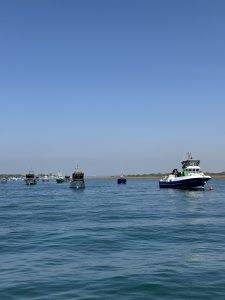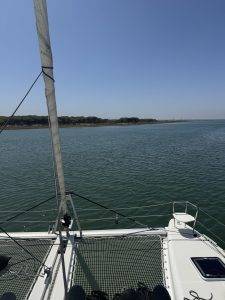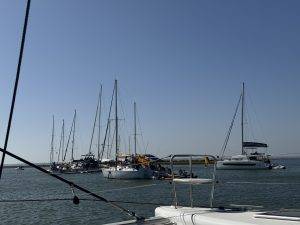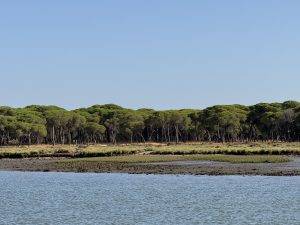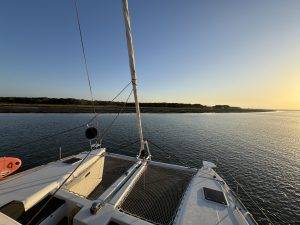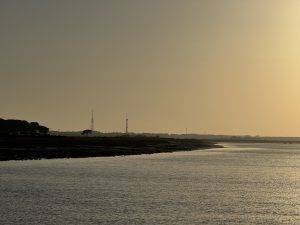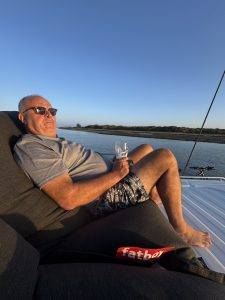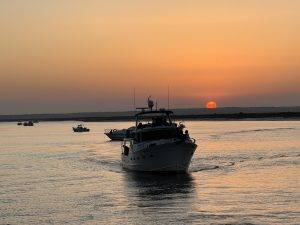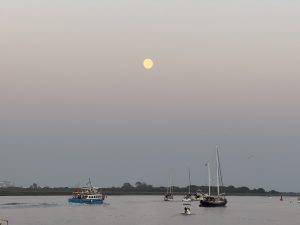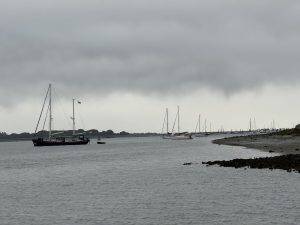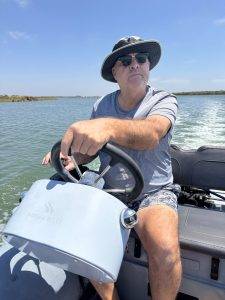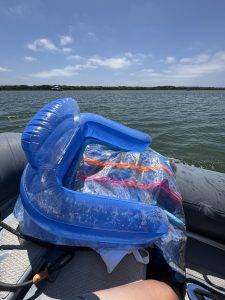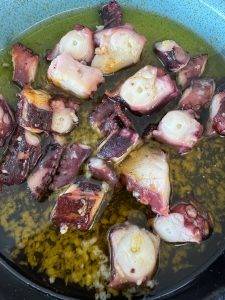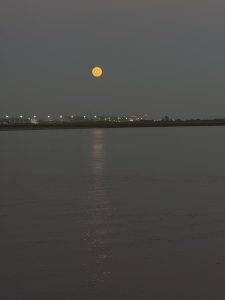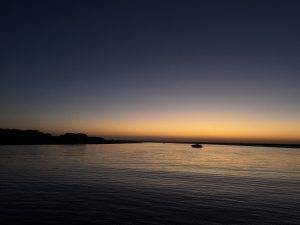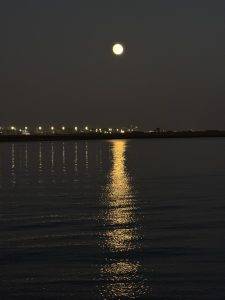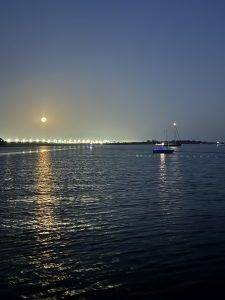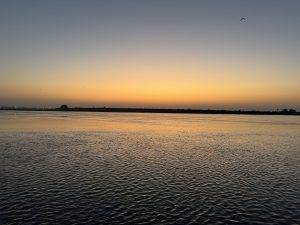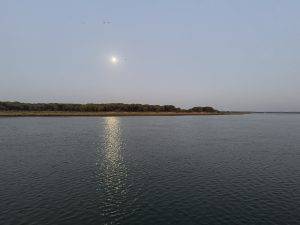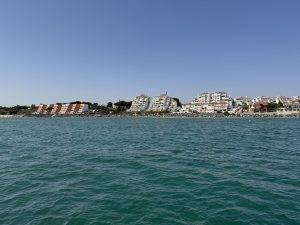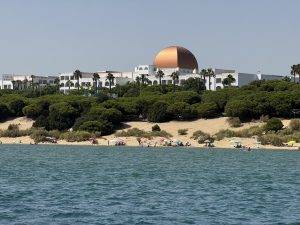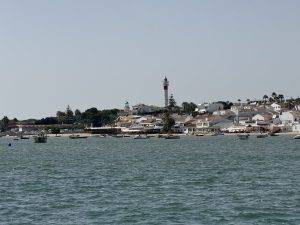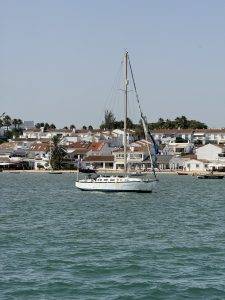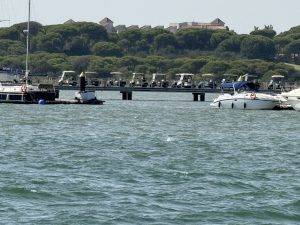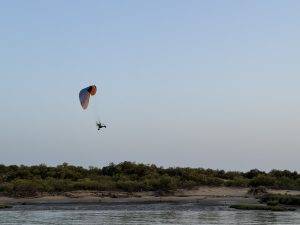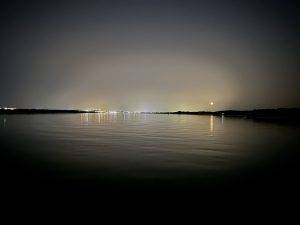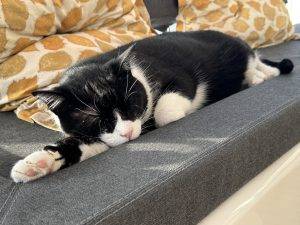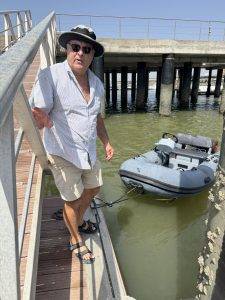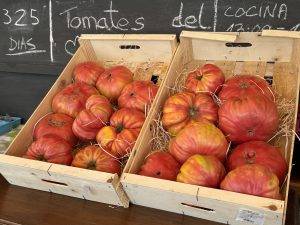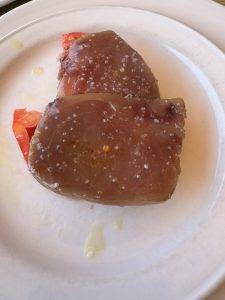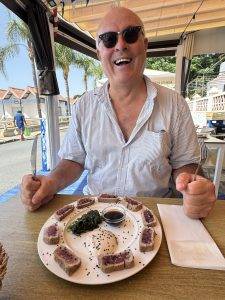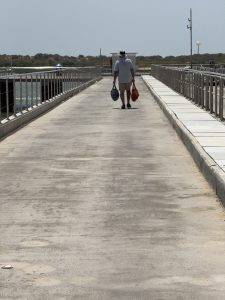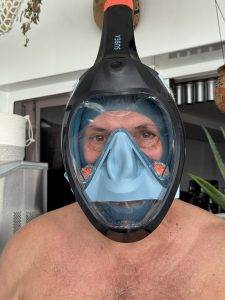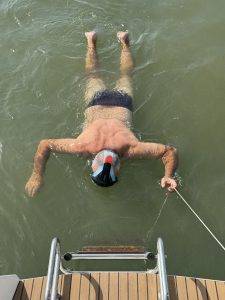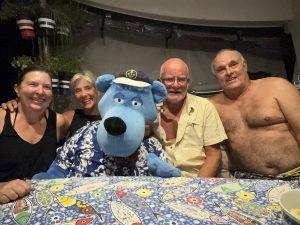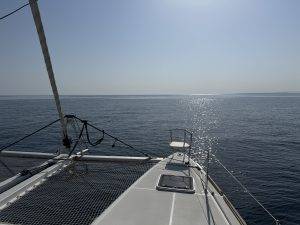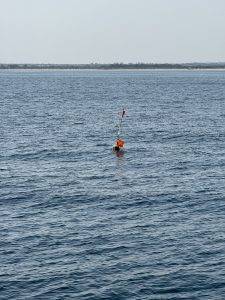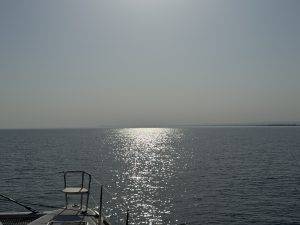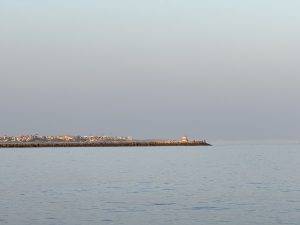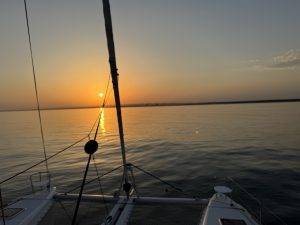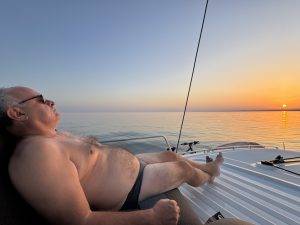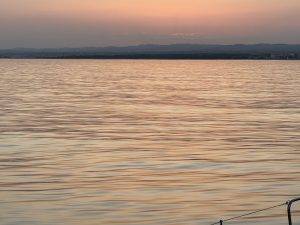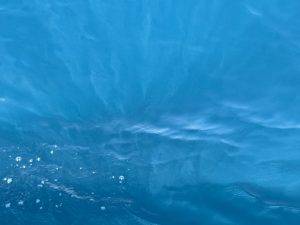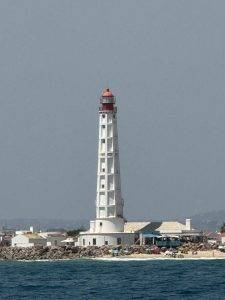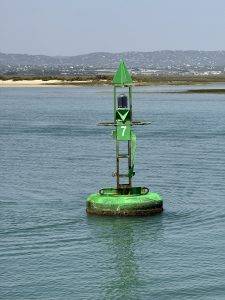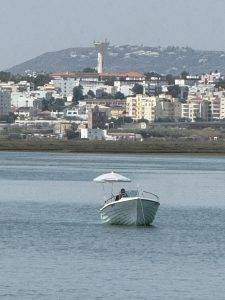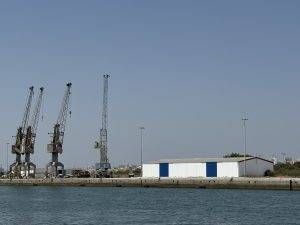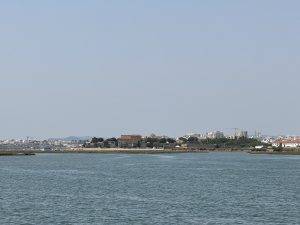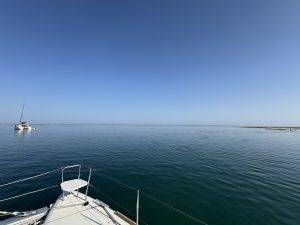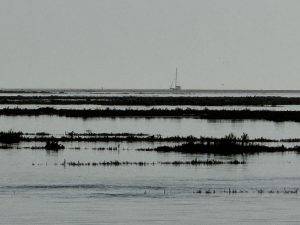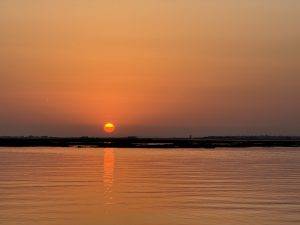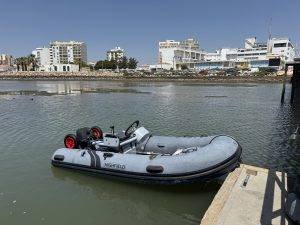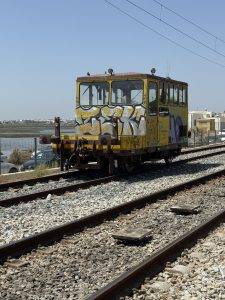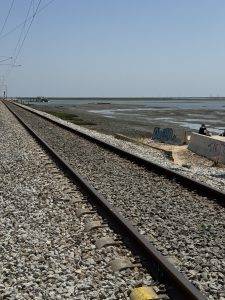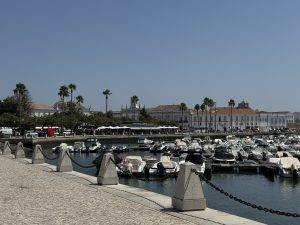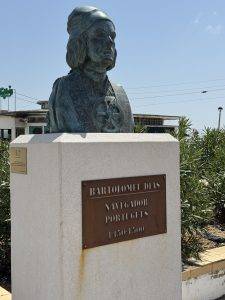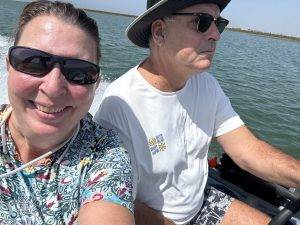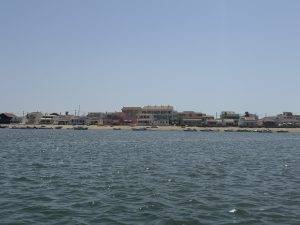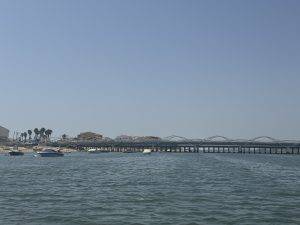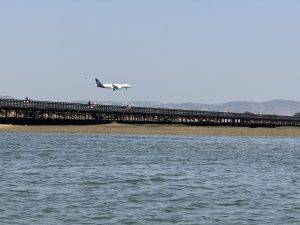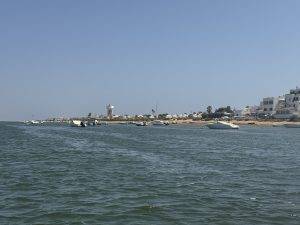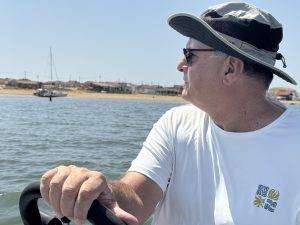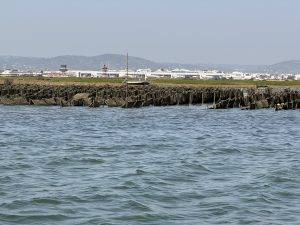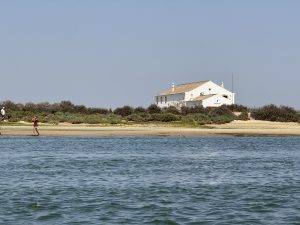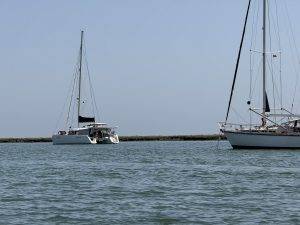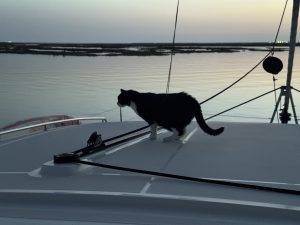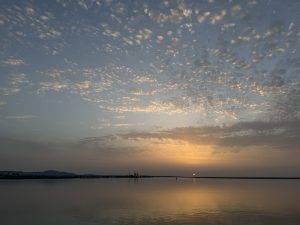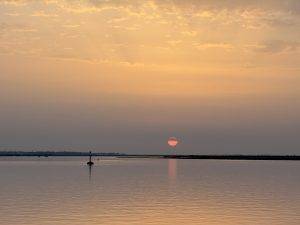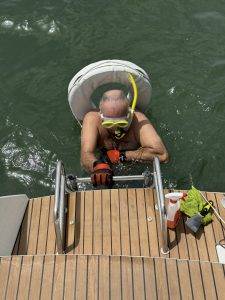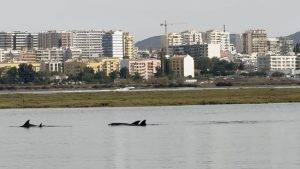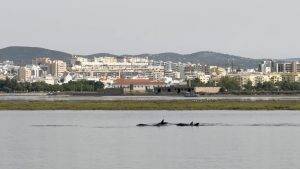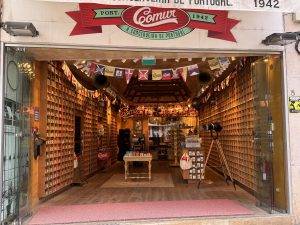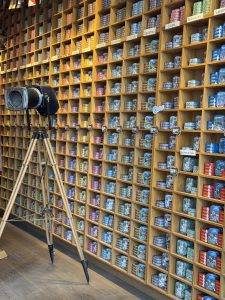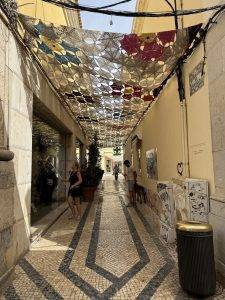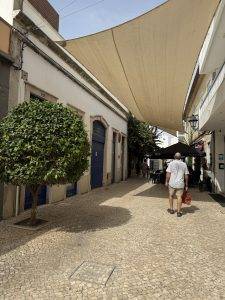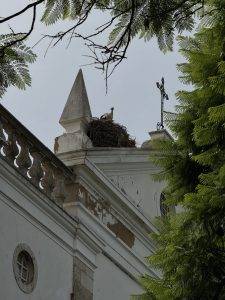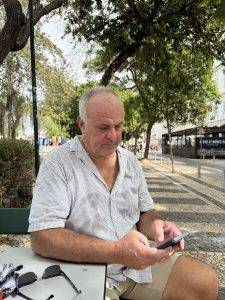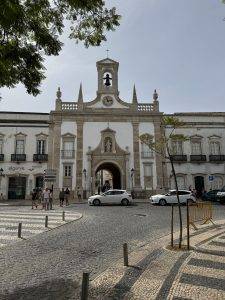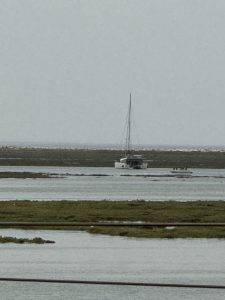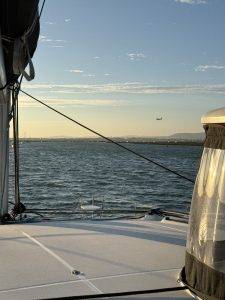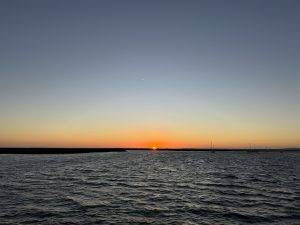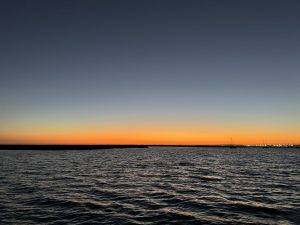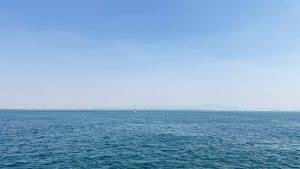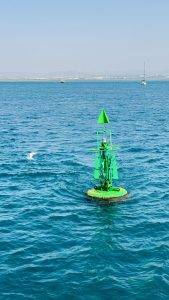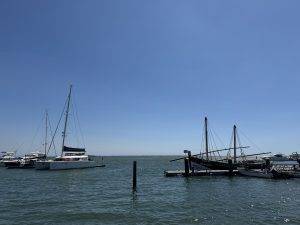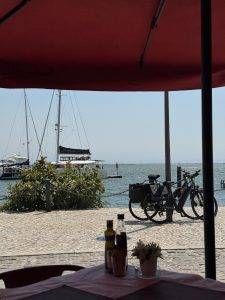After almost two months, we are casting off once again and setting sail from Huelva. A little earlier than planned, as we actually wanted to stay until mid-August. But a new heatwave with temperatures of 41°C is on its way and we want to escape it if possible. Further west and along the coast, slightly lower temperatures are forecast and, above all, we hope to be able to cool off a little by swimming in the water while at anchor.
Huelva – Punta Umbria 22,2 nm
After checking out and saying goodbye, we leave Marina del Odiel at 10 a.m. We have chosen calm water for casting off so that we can leave our berth in the corner without any difficulties. In addition, it is usually nice and windless in the morning. Today is no exception. Unfortunately, this also means that we first have to sail against the rising tide out of the Rio del Odiel. Once again under motor, as there is no wind expected for the next few days. It is also quite hazy, so the industrial plants are barely visible. After passing the outer pier, the weather improves and we motor along the coast on a mirror-smooth Atlantic. After a few miles, we reach the approach buoy for Punta Umbria. As the entrance is marked by a sandbar – a shallow spot – we navigate carefully through the well-buoied channel towards Punta Umbria. Passing the bustling tourist resort and a huge fleet of medium-sized fishing boats, we continue to the Canal de las Madres. Here, far away from the hustle and bustle and in front of a beautiful pine forest, we find a nice anchorage for ourselves. There is still a lot of traffic here from recreational boats, but fortunately the crowds of noisy motorboats and jet skis stay away. At least, that’s what we think! In the afternoon, there suddenly seems to be an exodus from the marinas of Punta Umbria, and we are suddenly no longer alone at our beautiful anchorage. A dozen yachts are suddenly moored in a small group, and everyone is enjoying the afternoon in high spirits. Numerous small fishing boats join them. It gets crowded, but fortunately not too loud or intrusive. The Spaniards are in a good mood and sing together. While we want to watch the sunset from our rooftop terrace with an alcohol-free wheat beer in the evening, the situation escalates after all. In a positive sense! The anchor pack breaks up boat by boat. However, this is not done quietly, but accompanied by loud singing from the crews. The boats are quite overloaded, with 20-30 people on deck. Before the boats leave, they circle those still at anchor and engage in a singing competition. It’s a great atmosphere that probably only exists in Spain. After we finally have our anchorage to ourselves again, we can enjoy the beautiful evening atmosphere and spend a very quiet night.
The next morning starts cloudy. A completely unfamiliar sight! And cool, which is even more unfamiliar. It was so chilly during the night that we actually had to snuggle up in our blankets to keep warm. And we left Huelva because of the heatwave that was forecast! Fortunately, neither lasts long. The sun quickly burns away the clouds and warms the air again. While we are still thinking about what to do next, our new neighbor Hans from El Kave stops by for a chat. He has been anchored here with his wife for two weeks and is also traveling at a leisurely pace like us. We exchange information about ports and anchorages, and before we know it, it’s afternoon. After Hans sets off in his dinghy to go shopping, we decide to stay at anchor for the day and take a trip to the Marismas in our inflatable boat. However, there isn’t much to see from the boat. We chug along to the left, whiz to the right and salvage a broken floating seat from the water. At least that’s one less piece of plastic in the water. Unfortunately, there’s far too much of it floating around here! Numerous plastic bottles and cans make you think about the advantages of a deposit system for cans and disposable items. Unfortunately, this doesn’t exist here in Spain. Back on board, we stay in the shade, as the sun is now beating down again. We end the day with a nice sundowner, octopus in garlic oil and a view of the moon growing larger and larger.
The next day, we laze around in the morning and try not to let the jet skis and motorboats whizzing around annoy us too much. Not so easy, given the crowds! Around noon, we visit La Kave and arrange to meet Hans and Anja for a barbecue in the evening. Back on board, we immediately start preparing a salad and baking flatbread. The flatbread is quick and easy to make and bakes super fast in our air fryer. Hans and Anja also bring salad and burgers, so we have a proper meal on the table. We chat comfortably until late in the evening, watching the big red moon in the sky. It’s a shame you can’t photograph it very well. The boat is too wobbly and the harbor lights in Huelva are too bright.
Punta Umbria – El Rompido/Rio Piedras 14,9 nm
The next morning, I wake up bright and early before sunrise. Unfortunately, the dishes are already waiting for me. Some days, I really wish we had a dishwasher! But at least I can wash up with a beautiful view of the water. Not everyone has that. Even though we want to continue our journey today, we are in no hurry. We have to wait for high tide to get out of the sandbank off Punta Umbria, and we also need high tide to reach our next anchorage at El Rompido, where we will also have to navigate the sandbank to get into the Rio Piedras. This means we can potter around until the afternoon. It is not until 2:30 p.m. that we weigh anchor and set off. First we head out of the side arm of the Rio del Odiel, then a little way along the coast and finally turn right into the Rio Piedras. We pass both sandbanks with plenty of water under the keel. Well calculated. In the Rio Piedras, we pass numerous vacationers eager for the beach and a swim. In some places, it feels like every square centimeter is covered with parasols and towels. Four marinas line up one after the other on the starboard side. On the port side, a kilometer-long sandy beach stretches along a dune to the Atlantic. The water is teeming with jet skis and motorboats. We sail past El Rompido and drop anchor off the dune landscape. Here, the hustle and bustle is a little less noticeable and a little later we enjoy the beautiful evening atmosphere. Unfortunately, it doesn’t really get any quieter at our anchorage after dark. Disco music blares over to us from the village of El Terron all night long until 6 a.m. It only gets quieter at dawn. Later, we find out that El Terron is home to one of the largest open-air discos. Oh well…
Despite the noise during the night, I wake up early in the morning and watch the sun rise. Even though Axel thinks I’ve photographed enough sunrises and sunsets in my life, I just can’t resist. They’re too beautiful and, in my opinion, always a little different. Since we have unfavorable tides for continuing our journey over the next few days, we decide to stay in Rio Piedras for another day. We also have visitors coming in the evening that we don’t want to miss. Around noon, we get our dinghy ready and head to El Rompido. There, we can conveniently park the dinghy at a floating dock. It’s just a short walk to the public trash cans to dispose of our trash. Another short walk and we’re sitting in the La Marea restaurant enjoying a cool drink and delicious food. Slices of monster tomatoes with tuna, prawns in garlic oil, and tuna tataki. Very tasty!!! Afterwards, we walk a short distance to the supermarket, where we stock up on a few fresh groceries. Back on board, it’s time for a siesta. The heatwave has now reached us and it’s too hot to move. Axel tries out his new full-face snorkel mask to cool off and jumps into the water. The water is too brackish for me, so I prefer to sweat. Axel then starts our watermaker for the first time, which starts up without a murmur and produces fresh water. However, the water smells pretty bad, so we can’t fill our tanks with it. The watermaker will have to be cleaned again in the next few days. In the evening, Angelika and Thomas from the Manatee come to visit. We last saw them in A Coruña and are happy to see them again. It’s a fun and long evening together, which we hope to repeat a few more times.
El Rompido/Rio Piedras – Rio Guadiana 24,2 nm
Luckily, the open-air disco isn’t too annoying tonight. Instead, Lucky wakes me up just in time to see one of the Perseid shooting stars. So I’ve already made a wish! Otherwise, the day starts off hot again. It’s already 30°C at 10 a.m. The forecast for today is over 40°C for the region. We stay in the shade and cool down with plenty of water. All the fans are running, so it’s bearable. At quarter past three, we weigh anchor and motor back against the current to the river mouth, feel our way over the sandbar, and set course for the west. There’s hardly a breath of wind ruffling the water, so we continue motoring, of course. At least the wind over the cooler Atlantic water provides a little cooling. We chug leisurely along the coast until we reach the entrance to the Guadiana border river. Given the calm weather, we spontaneously decide not to enter the river, but to anchor on the Portuguese side of the outer mole. There is a slight swell there, which lifts La Ola up and down, but the water is crystal clear and not brackish like in the river. We also gain an hour. In Portugal, we are now an hour earlier than we were five minutes ago on the Spanish side. Luckily, the clocks change automatically, so we don’t have to do any complicated calculations. This means we can have dinner at 7:30 p.m. instead of 8:30 p.m. Afterwards, we enjoy the sunset with an unobstructed view of the Portuguese coastline. We stay sitting in our comfortable beanbags on the roof terrace until it gets dark and enjoy the cool evening breeze. The gentle swell rocks La Ola gently back and forth, we can hear the surf from the shore, and there seems to be a fair with a Ferris wheel in Monte Gordo. Finally, we move to the cockpit, where Axel inquires about cleaning our watermaker. Meanwhile, I sit next to the cockpit and stare at the sky. As the moon is not yet out, we can actually see a few shooting stars from the Perseids streaking across the sky. Some of them have very long tails and span the entire sky. After making a few wishes and waiting for the moon to appear, we eventually retire to our bunks sometime before midnight.
Rio Guadiana – Canal de Faro/Ria Formosa 30,1 nm
Lucky is happy because I’m getting up at 2:30 a.m. to wake him up. He probably thinks she’s finally figured it out and that now is the perfect time for an early breakfast. Fat chance! There’s no food. Instead, I sit outside and look up at the shooting stars again. Unfortunately, the moon is now quite bright and only the „thick“ shooting stars are visible. But it’s enough for a few more wishes. Then it’s back to bed, where Lucky accompanies me and actually sleeps through until 8 a.m. without complaining. After a delicious breakfast, we head for a refreshing swim in the Atlantic. The water is beautifully clear and, at 25°C, just right for swimming. After a quick shower with fresh water, we weigh anchor again. Once again, there is too little wind today, so we motor on as usual. Finally, we reach the main entrance to the Ria Formosa and are once again amazed by the strong current and the resulting eddies. This time, we don’t turn to starboard and moor off the island of Culatra, but turn our bow to port and head towards Faro. After a few miles and a few turns through the marshland, we drop anchor in the Canal de Faro. What wonderful peace and quiet! Hardly any motorboats, even fewer jet skis, and only the occasional sound of aircraft. While we look at the old town of Faro on one side, on the other side there is a huge floodplain, which turns into a lake stretching for miles as the water rises. Numerous birds take advantage of the opportunity and wade through the shallow water in search of food. Unfortunately, countless flies also take advantage of the opportunity to swap their underwater territory for our catamaran. It is swarming with flies of all shapes and sizes. So paradise has its downsides too. But luckily, a little later, hundreds of swallows are flying around us, catching the tasty morsels. Unfortunately, they can’t catch all the pests. Only when the tide starts to go out do most of the flies disappear back into their dry homes. We enjoy the rest of the evening on board and are delighted to see another beautiful sunset.
The night at anchor is very calm, and I see a few more shooting stars. Towards morning, the wind picks up a little and blows a pleasant cool breeze into our cabin. Axel thinks it’s too cool, but the thermometer still reads 25°C. After breakfast, Axel starts cleaning our watermaker membrane. This involves flushing it through with a cleaning fluid. The rinse water comes out pretty dirty and musty. Afterward, the water produced by the watermaker is not only desalinated, but also no longer smelly. Wonderful, because now we can replenish our water supply and enjoy the next few days at anchor even more relaxed. Meanwhile, I try out a new bread recipe for the air fryer. In the heat, the bread can bake nicely in the cockpit and doesn’t heat up the inside of the boat. After just half an hour, the bread is ready and smells delicious. Once the work is done, we set off in our dinghy. Our first stop is just a few meters away to chat with our new neighbors. Angela and Marty, Americans from the sailing yacht Nada, give us tips for our planned shore leave and we spontaneously make plans for the evening. We continue on to Faro and moor behind the train station. We walk to the nearby Spar supermarket, where we buy some fresh groceries. A little later, we are back on board and happy that it is a little cooler and airier at anchor than in the city. In the evening, Angela and Marty come by and we enjoy a nice evening together. They want to continue eastward to Morocco in the next few days because their visas for the EU are expiring. But maybe we’ll see each other again next year.
After another quiet night, interrupted only by Lucky’s usual meowing, we start the new day at a leisurely pace. It’s a public holiday here in Portugal, so there’s a lot of recreational boating traffic. We don’t let it bother us, because here at our anchorage there’s only a fraction of the traffic we experienced recently in El Rompido. After successfully whiling away the morning, we take a short dinghy trip in the afternoon. We follow the channel further into the lagoon, past Faro Airport and on to Praia de Faro. Fortunately, mass tourism has not yet arrived here. The dunes on the Atlantic coast can be reached via a bridge or ferry. There are no large hotel complexes, but there is a campsite and hostels. Unfortunately, our attempt to land fails because we run aground. So we return to La Ola without having achieved anything, where we sit out the afternoon heat in the cockpit. In the evening, it fortunately cools down a little and I can practice playing the ukulele in the front cockpit again. Apart from the storks and herons in the marsh lakes next to our anchorage, I don’t disturb anyone. At sunset, Axel and I sit on the roof again. However, today La Ola does not turn us towards the sun, but lets us enjoy the vastness of the flooded landscape. Lucky joins us and examines all the anchored boats next to us with great interest.
How wonderfully quiet this anchorage is at night! There are no planes flying at night and no boat traffic either. Only the flowing water gurgles a little louder along the hull from time to time. Otherwise, there is the occasional snoring or meowing, and occasionally a bird crowing. Nothing else. Early in the morning, distant dog barking from the shore joins in. A fishing boat drifts quietly past us with the current. Only a slight splashing can be heard when the fishing rods are moved. I really like this morning atmosphere, so I enjoy getting up early with the first rays of sunshine. A carafe of water, a cup of coffee, and my iPad to record my thoughts here in the blog. As it is supposed to be very warm today and tomorrow, we postpone our next shore excursion to Faro until next week. Instead, water games are on the agenda for today. I try my hand at SUP and Axel cleans the underwater hull. Despite new antifouling in February, some barnacles have already spread. They can only be removed with a scraper. To give Axel a better grip in the water and so he doesn’t have to paddle constantly to stay in place, he uses our life jacket as a flotation device. It works really well and after an hour, the starboard hull is clean again.
The next day, it’s time to tackle the port hull. The water temperature is so pleasant that even I can jump right in. Normally, it takes me about half an hour to get to my belly button. The air temperature is also high enough that it’s nice to go into the water and enjoy the refreshment. While Axel cleans, I’m out on the SUP again. Although I can already stand up on the SUP, I prefer to cover the distances in deep water sitting down, because unfortunately I haven’t yet learned how to get back on the board in deep water if I lose my balance. I explore the anchorage and chat with our neighbors Timur and Louisa from the Vega and Marty and Angela from the Nada. Back at La Ola, we splash around a bit and finally relax in the shade of the cockpit. La Ola looks pico again underwater and Axel is happy with his day’s work. In the evening, the wind picks up a little and brings some cooling. The next few days are supposed to be a little cooler, although by cooler we still mean 30°C.
The new week starts out overcast. The Sahara is once again sending dust our way, obscuring the sky. In the Mediterranean region, this is currently causing stormy weather. One reason why we don’t want to go there. But even here, the overcast sky makes it oppressively hot and sweaty today. Nevertheless, we want to take a trip to Faro today. After hearing over and over again how beautiful Faro is, we want to make a third attempt to find the beautiful corners of the city. So far, they have managed to hide themselves very well from us. As we are getting the dinghy ready, Marty calls out to us from the Nada. He draws our attention to the canal, where a large group of dolphins are swimming along in complete tranquility. Sooo beautiful!!! We sail over to them briefly while the dolphins swim past us and back out to sea. Then we head for the pier in Faro, where we tie our dinghy up next to a few excursion boats. This time we don’t go into the old town, but turn left at the bandstand into the pedestrian zone. And lo and behold, Faro is actually very nice here! There are lots of cafés and restaurants, nice little shops, and pleasant shade overhead. We continue through the old town, which is still deserted and not very attractive to us due to a certain amount of renovation work. Fleeing the oppressive heat, we finally end up at the El Castelo restaurant and enjoy an early lunch with a view of La Ola anchored in the distance. Afterwards, we drag ourselves back to our dinghy through the scorching sunshine. Back on board La Ola, we just have enough energy to collapse in the shade of the cockpit. Luckily, we have refreshment right on our doorstep! A quick dip helps immensely. As we sit in the cockpit in the evening, still sweating even long after the sun has set, the wind suddenly changes direction. With the wind shift, it suddenly becomes cold. Suddenly, it’s no longer 30°C, but only 22°C. Bitterly cold for us! Since it’s almost bedtime anyway, we retire to our bunks a little earlier than planned. I snuggle under my warm duvet, which I never go without even when it’s over 30°C, while Axel shivers under the bedspread without a blanket and later gets an extra blanket. Brrrrr!!!!
The next morning starts off just as fresh, and the temperature doesn’t rise above 30°C all day. There’s still a decent breeze, so we spend the day without doing much with the outboard. But it’s nice to just hang out on board. We read, surf the internet, tinker with improvements to the boat, chat with sailing friends, and call Svea. And just like that, the day is over. For dinner, we have lasagna and another spectacular sunset. Is it the Sahara sand or the fine particles from the forest fires further north in Portugal? We don’t know, but the sunset here feels much more intense and lasting than in other areas.
Canal de Faro/Ria Formosa – Olhâo 8,3 nm
The next morning starts with an equally beautiful sunrise. You just have to be lucky enough to be woken up by Lucky in time to enjoy the play of colors. But actually, the cat alarm clock works very, very reliably. Today is no exception. After Lucky spent most of the night cuddled up with us in bed, his stomach growls so loudly at around 6:30 a.m. that he has to wake me up. The sun is once again giving its all today, painting the sky a cheesy red. While Lucky enjoys his breakfast, I admire the crescent moon with the two bright planets Jupiter and Venus next to it. Otherwise, the day starts quietly. After some lovely days at anchor, where we were able to endure the heatwave very well, we are moving on a little further today. We have managed to secure a berth in the marina at Olhâo for the next few days and move a short distance eastward in the late morning. As we sail through the lagoon, we notice how clean and litter-free the shores and the water are! In contrast to the Marismas del Odiel, where every square metre of the marshland shore was covered with plastic rubbish, here you can’t see a thing lying on the shore. If a plastic bottle does happen to float in the water, the excursion boats stop and collect it. If only people behaved like this everywhere in the world! The water in the lagoon is crystal clear at high tide and shimmers in Caribbean colors ranging from turquoise to dark blue. Surprisingly, the wind shifts to the southwest during our trip and blows at 4-5 on the Beaufort scale, even though the forecast was for northwest winds of 2-3. Not a problem in itself, unless you have to moor in a very narrow harbor. Although we have already submitted all the boat documents and our details when making the reservation, we first have to go to the reception jetty. However, it is occupied, so we are allowed to moor at the ferry landing stage. Not easy, as the wind is pushing us towards the shore and making it impossible to turn. In the end, however, Axel manages it perfectly once again, checks in and then, a little later, faces the challenge of casting off La Ola against the wind from the jetty. This maneuver is also mastered with ease and we are quickly on our way to our assigned berth. As was almost to be expected, we are assigned exactly the berth that was offered to us a year ago as a winter berth. And the one we gratefully declined at the time because it is located directly in the entrance and La Ola, with her port hull, now protrudes into the harbor like an extended jetty. The spot is „Indian“ – at the end of the passage. It is 350 meters to shore along a flooded and seagull-infested outer jetty. Numerous motorboats, water taxis, and excursion boats whiz by at high speed in front of the jetty, causing a lot of noise and swell. Well, we’ve been in worse places! We fondly remember Rohuküla in Estonia. However, we have rarely been in such a restless and remote location for so much money. Never mind, we wanted it this way and, in the end, we are right in front of the pretty market halls and close to the city center. Once La Ola is safely moored, we take our bikes and head ashore. First stop: the small restaurant Cais Club, directly opposite our mooring. There, Axel enjoys delicious chicken piri-piri and I have grilled cuttlefish. Well fed, we continue on to Lidl, which is located outside the city. It’s not easy to reach by bike, but we eventually find a way and are able to stock up on fresh supplies of bread, eggs, and oranges. Back on board, the morning wind has completely died down and the sun has warmed up the cockpit. Luckily, we were able to stock up on ice cream at Lidl and enjoy delicious peppermint ice cream on a stick a little later. We’ll be staying in Olhâo until the beginning of September and exploring the surrounding area. Axel is flying to Germany for Laura and Lars‘ wedding. My niece Svea is visiting me on board. I already have some activities in mind, from visiting a jazz bar and saltwater bathing in a saltworks to a guided nature tour in the Ria Formosa. Let’s see what we manage to do.






